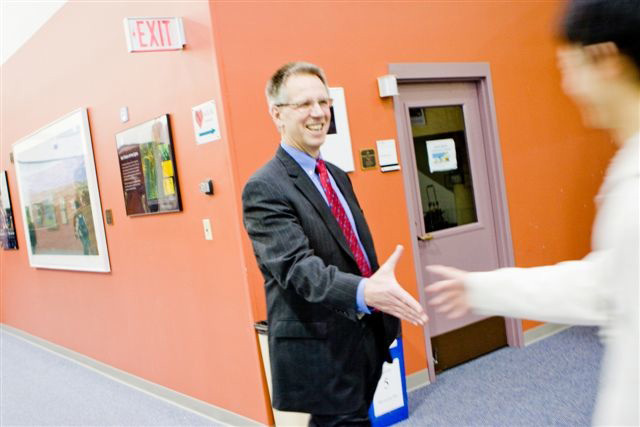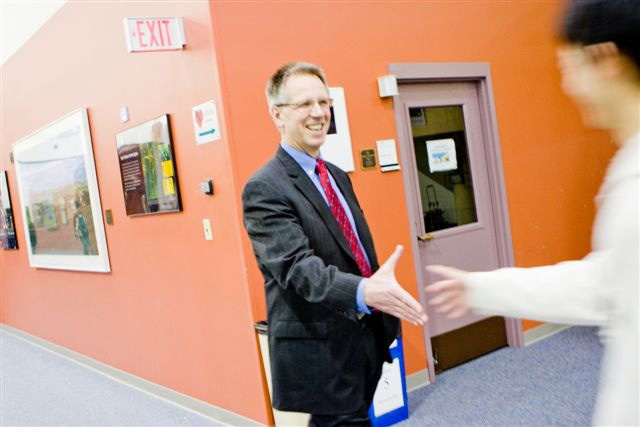Profile: Max McGee, President of IMSA, discusses some big ideas shares cutting-edge science and math

What's the big idea? There are a million of them at Illinois Mathematics and Science Academy (IMSA). Its president, Max McGee, shares a few with T&L.

Established in 1986 by the state, Illinois Mathematics and Science Academy, in Aurora, is an internationally recognized teaching and learning laboratory. It enrolls academically talented Illinois students (currently 650 students in grades 10 through 12) in its residential advanced college-prep program. Thousands of educators and students in Illinois and beyond are served through instructional programs that foster imagination and inquiry. IMSA furthers education through research, groundbreaking ventures and strategic partnerships. We spoke with Dr. Glenn “Max” McGee, who in 2007 was named the academy’s second president, a position that he says is exciting and presents “a chance to change the world.”
T&L: Is IMSA in the forefront of President Obama’s plans for improving STEM [science , technology, engineering and mathematics] education?
MM: Not yet, but we have some big plans. Arne Duncan, the new U.S. secretary of education, and I are great friends, and I had the chance to talk with him a couple of weeks ago as well as to meet with his staff and the staff of some Illinois congressional delegates to consider how IMSA can collaborate in developing a national plan for STEM education as part of the forthcoming reauthorization of the Elementary and Secondary Education Act. We hope to bring together other institutions like ours across the country to work with organizations with a history of strong federal support for STEM education, including the National Science Foundation and the Department of Defense, to work with Congress’s STEM Caucus to develop a coherent, coordinated plan that incorporates the president’s vision. With its 22-year history, IMSA can make an important contribution to a national plan.
T&L: You are a state agency, and IMSA forges connections with organizations in the private and public sectors to combine financial and intellectual resources that lead to new bodies of knowledge, services and programs. Who are some of your technology partners and donors?
MM: To name just a few, they include the Tellabs Foundation, one of our significant partners, which supports a professional-development space and just recently gave us a grant for our cool.hub project, which we will use to connect CoolSpots, i.e., a network of online affiliates and school, university, laboratory and business partners across Illinois. We will use this network to deliver professional development and work on dynamic problem-solving activities. We currently work with the Illinois Department of Commerce and Economic Opportunity to host a project with six schools and with a Chicago community organization to reduce energy consumption in schools. IMSA and DCEO provide the professional development, the technical support and some consulting expertise and are hosting a presentation day later this spring for schools to share their solutions.
ComEd, an Exelon company, has been an outstanding partner. It recently gave the IMSA Energy Center, our student-initiated center for experimenting with sustainable energy and exploring energy policy, a significant grant. It has been a longtime sponsor of the IMSA-ComEd CyberQuiz 4Kids. CyberQuiz presents online mathematics and science brainteasers and word problems for Illinois students in grades six through nine. Students who submit correct answers become eligible for random prize drawings and are invited to spend a morning with us.
Tools and ideas to transform education. Sign up below.
The Motorola Foundation is another partner that has given us extensive support in our problem-based learning for teacher professional development across the state. The Boeing Company, out of St. Louis, supports our summer residential camp in partnership with Southern Illinois University, in Edwardsville, which will serve middle-school students from the metro-east area who have not had the opportunities for or access to an inquiry-based science education. Both the Polk Bros. Foundation and another private foundation, which prefers to be anonymous, have been instrumental in helping us launch our field office at Doolittle School, on Chicago’s South Side, as well as explore plans for future expansion that may include another campus some years from now.
T&L: How does cool.hub work?
MM: The design of cool.hub.imsa creates communities of innovators across the state, the country and the world. Traditional roles—teacher, parent, student, expert, businessperson, researcher and inventor—blur as networks form around questions and problems of mutual interest. For instance, how can students create and use Web 2.0 personal learning networks to enhance learning? Or, how can cell phones be used educationally in addition to desktop or laptop computers?
Collaboration takes place face-to-face or online. CoolSpots, tech-enabled zones conducive for small-group work, serve as pathways to a robust virtual network that supports innovation and learning through video conferencing, online forums, wikis, blogs, immersive online worlds and a searchable database of session recordings and published innovation projects.
Initially, CoolSpots will be located on IMSA’s campus and in its field offices; however, anyone with access to the Web may participate in collaborative innovation. Students involved in the TALENT [Total Applied Learning for ENTrepreneurs] program use cool.hub.imsa resources to connect with research universities, national labs, state and federal government and business groups globally in pursuit of entrepreneurial applied-science and technology projects and ideas for commercialization.
T&L: During your recent visit to China, what about their technical education impressed you most?
MM: Their national commitment is both sobering and inspiring. They realize that their country’s future depends on high-quality STEM education and are beginning to jump into online learning. As with Korea, they realize that the future of education is not just in bricks and mortar. Also, I was impressed with their hands-on approach to science education in schools and even in their museums. I had planned to spend just an hour or two on the Shanghai Science and Technology Museum visit, but I ended up spending six hours there on a Sunday. Even on the weekend, the museum was alive with school field trips, and children and adults were engrossed in an incredible number of hands-on and high-tech activities—including competing with a robot in an archery competition! America needs to emulate this cultural commitment to making exploration of mathematics, science, technology and engineering part of our lives, and I know that IMSA can be a leader in this regard. Innovation is in IMSA’s DNA, as is our mission to ignite and nurture minds that will advance the human condition. We need to lead, collaborate and strive to expand this vision and reach.
